Project March Blog
Project MARCH is a multidisciplinary team of 28 students. The project aims to improve the quality of life for people with spinal cord injuries.
Project MARCH is a multidisciplinary team of 28 students. The project aims to improve the quality of life for people with spinal cord injuries.
This year, the team faces a major challenge: participation in CYBATHLON 2024, the largest bionic competition in the world. During this competition, Project MARCH will compete with their exoskeleton against companies and university teams from around the world. But how do you create an exoskeleton that is strong enough, not too heavy, and can be produced by the student team, while also taking into account the obstacles that must be overcome at the Cybathlon? These were the questions confronted by the mechanical and software engineers of Project MARCH IX and which they had to answer. Femto Engineering is an expert in solving these kinds of challenges and thus perfect for supporting the engineers of Project MARCH.
The Cybathlon consists of eight disciplines of so-called ‘assistive technology’. Project MARCH participates in the exoskeleton race. This race comprises ten obstacles, all based on daily life activities that may feel very normal but can be challenging for people with a spinal cord injury who are in a wheelchair. The previous Cybathlon was held in each participant’s own country due to the COVID-19 pandemic. A video of the exoskeleton race from 2020 can be found at the following link:
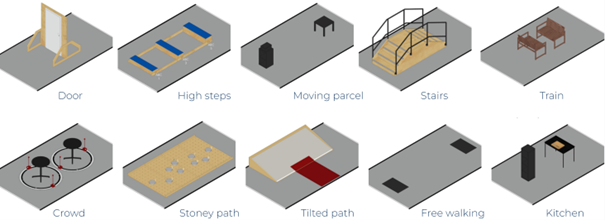
Femto supports Project MARCH in using two programs, namely Simcenter 3D and Simcenter Amesim. Simcenter Amesim is used by the software engineers for accurately modeling the exoskeleton. Because we work with a pilot, who is the person with a spinal cord injury walking in the exoskeleton, there are many safety regulations we adhere to. The simulation of the exoskeleton ensures that the software engineers can test their software in a safe manner, and the pilot can later control the exoskeleton with confidence.
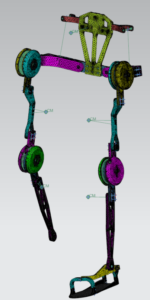
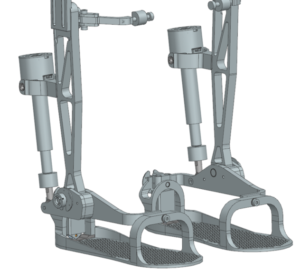
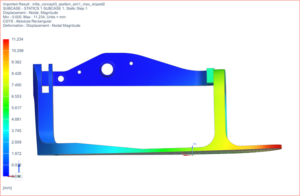
Simcenter 3D is used by the mechanical engineers for finite element analysis (FEA). With this finite element analysis, the stresses in the components of the exoskeleton are calculated to validate that these parts are strong enough. Based on this, material choices are made, for example. The overall exoskeleton is also analyzed in an assembly FEM. In this analysis, the entire exoskeleton is examined with various load cases, such as falling on one foot. Because it is important for the pilot of the exoskeleton during the Cybathlon to ensure that the exoskeleton is as easy to move in as possible, it is also crucial that the exoskeleton is as light as possible. By applying a finite element analysis to the frame of the exoskeleton, the shapes of frame components can be optimized for the loads they experience.
In the following paragraph, we will delve deeper into the process of reducing the mass of the exoskeleton.
To reduce the mass of the exoskeleton, the frame parts were redesigned. With the guidance of Femto, the load cases on the frame parts and the safety factors used were carefully evaluated and reconsidered, this is a critical step to an optimized frame design. As a result, a set of expected and extreme load cases were created. This distinction was made because the requirements are different for each set. This was very valuable lesson that made the load cases a better representation of the real life loads on the exoskeleton.
To actually redesign frame parts, topology optimization was used in the leg frames for example. This algorithm redesigns frame parts based on the loads and constraints that are specified. These results were then used to make leg frames that are more optimally designed for the loads that they will encounter during use. This process is shown in image 1. However, these models are very sensitive to the inputs that are given. It was therefore very helpful to learn from experienced engineers at Femto what to look for and how the results of the topology optimization could be used and more in general how the results from simulations should be interpreted, since optimization is always a trade-off and the exoskeleton has to be strong enough to deal with loads that were not foreseen.
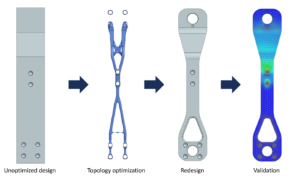
In the past months Project MARCH produced and assembled the exoskeleton, see image 2 and 3. As a result of the extensive finite element analyses that were performed with Femto, the current assembly is approximately 25% lighter than the previous exoskeleton. A significant loss of mass that will help the pilot to navigate the obstacles easier.
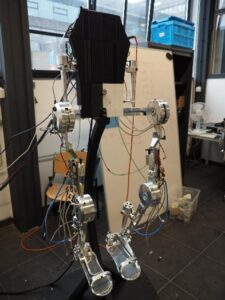
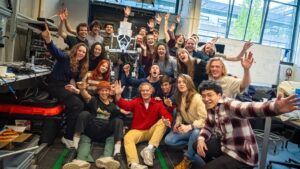
Do you need more information or want to discuss your project? Reach out to us anytime and we’ll happily answer your questions.
At Femto Engineering we help companies achieve their innovation ambitions with engineering consultancy, software, and R&D.
We are Siemens DISW Expert Partner for Simcenter Femap, Simcenter 3D, Simcenter Amesim, Simcenter STAR-CCM+ and SDC verifier. Get in touch and let us make CAE work for you.
Sign up for our newsletter to get free resources, news and updates monthly in your inbox. Share in our expertise!